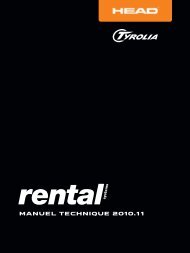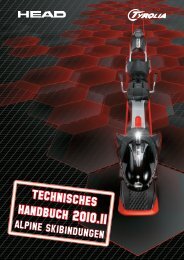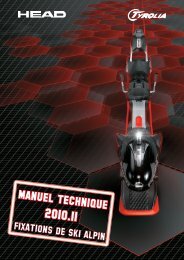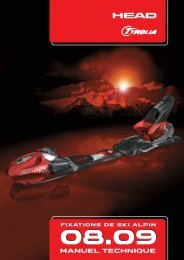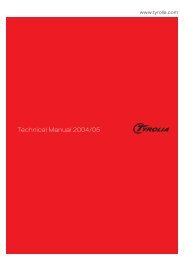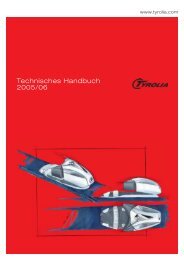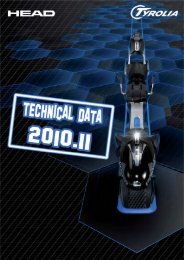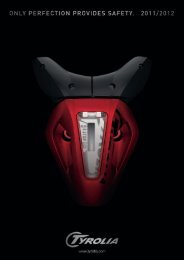You also want an ePaper? Increase the reach of your titles
YUMPU automatically turns print PDFs into web optimized ePapers that Google loves.
test results which exceed allowable limits.<br />
The magnitude and frequency of these deviations<br />
determines the frequency of future inspections.<br />
Shops which fail an inspection must sample daily<br />
until the source of the problem is found and corrected.<br />
Then, as inspection results improve, the<br />
frequency of sampling and inspection is relaxed.<br />
Inspection Procedures<br />
Important Terms<br />
Correction Factor<br />
The value that must be added or subtracted from<br />
the initial visual indicator setting to bring the result<br />
within the Inspection Tolerance (or Inspection<br />
Range).<br />
Directions of Release<br />
Unless otherwise specified (see In season Inspection),<br />
the directions of release to be tested are<br />
forward lean and clockwise and counter clockwise<br />
in twist.<br />
Test Device<br />
A device which meets ISO standard 11110 or ASTM<br />
standard F1<strong>06</strong>1 and has been checked and maintained<br />
in the manner specified by the device<br />
manufacturer.<br />
Test Result or Release Torque<br />
The middle quantitative value of three tests made<br />
in the same direction.<br />
Preseason Test<br />
Reference Boot Selection<br />
The Reference Boot is a boot of a designated sole<br />
length which is otherwise typical of the boot inventory.<br />
Use the procedure below if the boot inventory<br />
includes several models and a representative<br />
boot can not easily be identified.<br />
1. Select five single boots with sole lengths as<br />
specified in Table [A] for the binding type to be<br />
tested: adult, junior, or child.<br />
2. Clean all five boots with a mild detergent and<br />
water.<br />
3. Adjust a rental binding to the release indicator<br />
setting specified in Table [A] for the binding<br />
type.<br />
4. Fit the binding to the boot and determine the<br />
Release Torque in all three directions of release<br />
(forward lean and both directions in twist-three<br />
releases in each direction).<br />
5. Average the Release Torque for CW (clockwise)<br />
and CCW (counter clockwise) twist release.<br />
6. Reject and replace any boot with a CW to CCW<br />
difference of more than 6 Nm for adult boots<br />
or 4 Nm when testing child boot types.<br />
7. Rank the five twist results and select, as the<br />
Reference Boot for twist, the middle boot.<br />
8. Rank the five forward lean results and select,<br />
as the Reference Boot for forward lean, the<br />
middle boot.<br />
Preseason Binding Inspection<br />
RENTAL/ 49<br />
The procedure that follows is an integral part of<br />
pre-season maintenance. It is also a good way to<br />
determine if maintenance and which units have<br />
outlived their usefulness and must be removed<br />
from inventory.<br />
1. Clean areas of the bindings that contact the<br />
boot and perform all preseason binding maintenance.<br />
2. Visually or manually check:<br />
a.) AFD condition.<br />
b.) Brakes function.<br />
c.) Release indicator readability and travel.<br />
d.) Screw tightness.<br />
3. Adjust each binding with the reference boot,<br />
then adjust the release value indicators to the<br />
specified value found in Chart A,<br />
4. Check that the heel track and toe track Single<br />
Code agree with the sole length Single Code<br />
of the reference boot.<br />
5. With the Reference Boot in the binding, verify<br />
elastic travel of the toe piece by striking the<br />
boot toe with a mallet or dead hammer and<br />
checking that the toe piece returns the boot<br />
quickly and completely to center.<br />
6. Verify elastic travel of the heel piece by lifting<br />
the boot while depressing the heel piece<br />
cocking lever and checking that the heel<br />
piece returns the boot quickly and completely<br />
to the latched position.<br />
7. <strong>Manual</strong>ly release the binding 3 times in each<br />
direction.<br />
8. Lubricate all boot/binding interfaces with a<br />
mild liquid detergent and water solution.<br />
9. With the Ski Binding Test Device determine<br />
the Release Torque for each direction of<br />
release (forward lean and both directions in<br />
twist).<br />
10. Record “PASS” in the bindings maintenance<br />
record if Test Results are within the Inspection<br />
Range provided inTable [A].<br />
11. Set the ski aside if the Test result in any<br />
directions of release is outside the Inspection<br />
Range in Table [A].<br />
12. Follow Troubleshooting Procedure on page<br />
60/61 for units which have been set aside and<br />
retest if changes in the unit’s condition or<br />
adjustment are made.<br />
13. Record “FAIL” in the binding’s maintenance<br />
record if, after troubleshooting, test results<br />
in any direction of release are outside the<br />
In-Use Range. Replace the “failed” unit and<br />
retest before returning the ski to service.<br />
14. If after troubleshooting, Test Results are outside<br />
the Inspection Range but within the In-Use<br />
Range, apply a Correction Factor to the unit<br />
and note the Correction Factor for that unit in<br />
the binding’s maintenance record.



